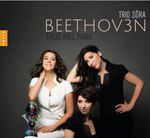|
Back
01/13/2021
“Beethov3n”
Ludwig van Beethoven: Piano Trio n° 1 in E-Flat major, opus 1 – Piano Trio n° 2 in G major, opus 1 – Piano Trio n° 3 in C minor, opus 1 – Piano Trio n° 1 in D major, opus 70 “Ghost” – Piano Trio n° 2 in E-Flat major, opus 70 – Piano Trio in B-Flat major, opus 97 “Archduke”
Trio Sōra: Pauline Chenais (piano), Clémence de Forceville (violin), Angèle Legasa (cello)
Recording: Théâtre populaire romand, La Salle de musique, La-Chaux-de-Fonds, Switzerland (October 19-23, 2019) – 189’31
Naïve Classiques V 7080 – Booklet in French and English

   
Like a fresh spring breeze, Trio Sōra sweeps through Beethoven’s six mature piano trios with vitality, virtuosity and delight in a 3-CD set honoring the composer on the 250th anniversary of his birth. These works include Beethoven’s very first opus number (opus 1, n° s 1-3), the “Ghost Trio” (opus 70, n° 1) and its partner, opus 70, n° 2, and the magnificent “Archduke Trio” (opus 97).
Composed of three young women of exceptional musicianship, the Trio Sōra brings to Beethoven’s first opus—completed when he was in his early 20s—the kind of youthful high spirits the composer himself must have experienced as he began to feel his wings and chart his future course.
From the first notes of the n° 1 in E-Flat major, the trio displays an individual touch and ensemble cohesion which is light, playful and enchanting. Imagine the energy and verve of the young Beethoven, winding up his studies with the cautious Haydn and with an eye on conquering the musical world. The first movement is a portrait of delight with a wink. This performance of the serene “Adagio cantabile” of movement two includes expressive dynamics that may or may not have been in the original score, but it adds the depth of feeling the young composer was to bring to his listeners time and again. What a sweet duet between violin and cello less than two minutes into this movement and a nice long piano trill later on, foretelling many such to appear in the composer’s future compositions. The trio is chock full of effects he will use throughout his life, including sforzandos, playful grace notes and patches of dead silence. The four-movement work builds to a stunning peak, only to end with an abrupt pianissimo, perfectly executed by the artists.
Following the sunny Piano Trio n° 2, the ensemble performs the Trio n° 3 in C minor. This is the work that the composer’s teacher, Franz Josef Haydn, cautioned him not to publish because its radical nature would harm the young man’s chances of employment. Here the Trio Sōra reveals not only Beethoven the spirited dreamer, but also the moody philosopher and singer of dark songs. There is a liberating freedom in this performance which quickly switches from frenetic to lyrical to relentless in the captivating fourth movement. Once again, the piano, played brilliantly by Pauline Chenais, is the backbone of these renditions.
This is good place to insert a couple of critical observations. Throughout these recordings, staccato notes could have been articulated with greater crispness. Of course, that is difficult-to-impossible in some of the rapid passages.
More problematic is the tendency of the violin, played lyrically by Clémence de Forceville, to be lost in the mix. I believe this to be a recording glitch rather than an artistic choice. The piano (Pauline Chenais) was always front and center, loud and clear, while the cello (played sonorously by Angèle Legasa) often sounded dynamically balanced with the piano. Often, however, it was difficult to hear the violin. The effect was occasionally one of a piano recital—and a very good one—with a sprinkling of strings on top. Yet in spite of this, the trio’s overall performance, throughout all three disks, was brilliant and, at times, absolutely breathtaking. There is a unique synergy, camaraderie and shared understanding among these three artists that makes their interpretation of the trios irresistible.
The Piano Trio n° 1, opus 70 is known as the “Ghost Trio” for a number of reasons, but the most germane to our listening experience is the second movement itself, a work remarkable in the context of its time and, indeed, for any time. The second movement begins softly and quietly, building to a torrent of rhythms, mostly in the piano, with a menacing halo of strings. With its peculiar development and eerie theme, no work ever deserved the name “ghost” as this one, a treat to follow in score as well as by ear, what with its clouds of dark 64th notes hovering over the page like a murmuration of blackbirds.
The Piano Trio n° 2 in E-Flat major, with four spritely movements, is a horse of a different color. The Trio was born to play the lyrical lines of the first movement which float over cascading triplets (if triplets can in fact cascade upward). The ensemble finesses Beethoven’s just plain weird chromaticisms in the long third movement, returning to stability in a glorious finale.
The best for last, but I am afraid I have run out of space. I urge readers to seek out the Trio Sōra’s “Archduke” if nothing else (opus 97 completed in 1811 when the composer was 40). This performance sings, from the architectural masterpiece which is the first movement, to its diabolical “Scherzo” and “Andante cantabile” (the dolce entrance of the strings is one of the sweetest sounds you’ll ever hear). The Trio, and in fact the entire album, concludes with a fourth movement full of flickering personality changes, culminating in a satisfying end.
The six piano trios of Beethoven: a shape-changing universe captured by three wise and very talented musical “sisters”.
Linda Holt
|